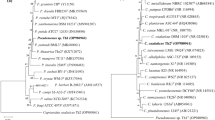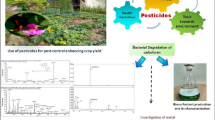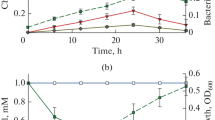Abstract
In India, propiconazole, a triazole group fungicide, is broadly used against powdery mildew, rusts, and leaf spot diseases of cereals and coffee. The toxicity of this fungicide is known to affect the quality of the soil. Hence, in the present study, a bacterium isolated from contaminated paddy soil was used to study the degradation of propiconazole under in vitro conditions. The isolated bacterium was confirmed as Pseudomonas aeruginosa strain (PS-4) based on morphological and biochemical characteristics, and 16S rRNA gene sequencing. When the isolated bacterium was grown in mineral salt medium amended with 10 μg/l propiconazole as a sole carbon source, culture filtrates of the bacterium utilized up to 8 μg/L of propiconazole after 72 h of incubation at 30 °C and pH 7, as analyzed by HPLC. Degradation of propiconazole by the bacterium was also aided by the secretion of three metabolites—1,2,4-triazole; 2,4-dichlorobenzoic acid; and 1-chlorobenzene—as determined by their mass spectra. Furthermore, induction of monooxygenase activity and the CYP450 gene was observed in the culture filtrate of strain PS-4, showing evidence of their role in the degradation of propiconazole. These results revealed that PS-4 is an efficient candidate for the reduction of contaminants present in the soil, thereby contributing to soil health and crop improvement.










Similar content being viewed by others
References
Abraham J, Silambarasan S (2013) Biodegradation of chlorpyrifos and its hydrolyzing metabolite 3,5,6-trichloro-2-pyridinol by Sphingobacterium sp. JAS3. Process Biochem 48:1559–1564
Attar M, Dong D, John Ling JK, Tang-Liu DSD (2003) Cytochrome p450 2c8 and flavin-containing monooxygenases are involved in the metabolism of tazarotenic acid in humans. Drug Metab Dispos 31(4):476–481
Babu NA, Jogaiah S, Ichi IS, Nagaraj KA, Tran PSL (2015) Improvement of growth, fruit weight and early blight disease protection of tomato plants by rhizosphere bacteria is correlated with their beneficial traits and induced biosynthesis of antioxidant peroxidase and polyphenol oxidase. Plant Sci 231:62–73
Bailey AM, Coffey MD (1985) Biodegradation of metalaxyl in avocado soils. Phytopathology 75:135–137
Bromilow RH, Evans AA, Nicholls PH (1999) Factors affecting degradation rate of triazole fungicides in two soil types: II. Field studies. Pest Manag Sci 55:1135–1142
Cain RB, Mitchell JA (1996) Enhanced degradation of the fungicide vinclozolin: isolation and characterisation of a responsible organism. Pest Manag Sci 48:13–23
Colson ES, Platz GJ, Usher TR (2003) Fungicidal control of Pyrenophoratritici-repentis in wheat. Australas Plant Pathol 32:241–246
Degtyarenko KN (1999) Structural domain of P450 containing monooxygenase systems. Protein Eng 8:737–747
Dong X, Hong Q, He L, Jiang X, Li S (2008) Characterization of phenol-degrading bacterial strains isolated from natural soil. Int Biodeterior Biodegrad 62:257–262
Ekler Z (1988) Behaviour of thiophanate herbicides in soil: adsorption and volatilization. Pestic Sci 22:145–157
Elhussein AA, Osman AG, Sherif AM (2011) Isolation, characterization, identification and potentiality of fungicide thiram (TMTD) degraders under laboratory conditions. Int J Appl Environ Sci 6(2):193–199
Elmholt E (1992) Effect of propiconazole on substrate amended soil respiration following laboratory and field application. Pest Manag Sci 34:139–146
Vaz F, Santos-Filho E, Silva S, Araújo S, Stamford-Arnaud T, Bandeira A, Brasileiro-Vidal AC, Pereira Stamford N, Aparecida Mouco M, Gouveia E (2015) Biodegradation of paclobutrazol—a plant growth regulator used in irrigated mango orchard soil. In: Rolando C (ed) Biodegradation and bioremediation of polluted systems. InTech, Croatia, pp85–107
Guengerich FP (2002) Cytochrome P450 enzymes in the generation of commercial products. Nat Rev Drug Discov 1:359–366
Hage JC, Hartmans S (1999) Monooxygenase-mediated 1,2-ichloroethane degradation by Pseudomonas sp. strain DCA1. Appl Environ Microbiol 65:2466–2470
Kim IS, Beaudette LA, Shim JH, Trevors JT, Suh YT (2002) Environmental fate of the triazole fungicide propiconazole in a rice-paddy-soil lysimeter. Plant Soil 239:321–331
Kim IS, Shim JH, Suh YT (2003) Laboratory studies on formation of bound residues and degradation of propiconazole in soils. Pest Manag Sci 59:324–330
Kloskowski R, Führ F, Mittelstaedt W (1987) The uptake of nonextractable soil-bound pesticide residues by roots-standardized experiments with four pesticides. In: Greenhalgh R, Roberts TR (eds) Pesticide science and biotechnology. Blackwell, Oxford, pp 405–410
Kulkarni AG, Kaliwal BB (2014) Bioremediation of methomyl by soil isolate- Pseudomonas aeruginosa. J Environ Sci Toxicol Food Technol 8(12):1–10
Larkin MJ, Kulakov LK, Allen CCR (2005) Biodegradation and Rhodococcus masters of catabolic versatility. Curr Opin Biotechnol 12:564–573
Li Y, Dong F, Liu X, Xu J, Chen X, Han Y, Liang X, Zheng Y (2013a) Studies of enantiomeric degradation of the triazole fungicide hexaconazole in tomato, cucumber, and field soil by chiral liquid chromatography-tandem mass spectrometry. Chirality 25:160–169
Li ZH, Zlabek V, Velisek J, Grabic R, Machova J, Kolarova J (2013b) Multiple biomarkers responses in juvenile rainbow trout, Oncorhynchus mykiss, after acute exposure to a fungicide propiconazole. Environ Toxicol 28:119–126
Mars EA, Kasberg T, Kaschabek RS, Van Agteren HM, Janssen BD, Reineke W (1997) Microbial degradation of chloroaromatics: use of the meta-cleavage pathway for mineralization of chlorobenzene. J Bacteriol 179:4530–4537
Megadi BV, Tallur NP, Mulla IS, Ninnekar HZ (2010) Bacterial degradation of fungicide captan. J Agric Food Chem 58:12863–12868
Meunier B, De-Visser SP, Shaik S (2004) Mechanism of oxidation reactions catalyzed by cytochrome P450 enzymes. Chem Rev 104:3947–3980
Miners JO (2002) Evolution of drug metabolism: hitchhiking the technology bandwagon. Clin Exp Pharmacol Physiol 29:1040–1044
Mitchell JA, Cain RB (1996) Rapid onset of the accelerated degradation of dicarboximide fungicides in a UK soil with a long history of agrochemical exclusion. Pestic Sci 48:1–11
Munier LC, Borde O (2000) Effect of a triazole fungicide on the cellulose decomposition by the soil microflora. Chemosphere 41:1029–1035
Nelson JD, Blair W, Brinckman FE, Colwell RR, Iverson WP (1973) Biodegradation of phenylmercuric acetate by mercury-resistant bacteria. Appl Microbiol 26(3):321–326
Nicole TS, Priscila SC, Maria DCR, Peralbaand Marco AZA (2009) Biodegradation of Tebuconazole by bacteria isolated from contaminated soils. J Environ Sci Health B 45:67–72
Obanda DN, Shupe TF (2009) Biotransformation of tebuconazole by microorganisms: evidence of a common mechanism. Wood Fiber Sci 41:157–167
Oltmanns RH, Muller R, Otto MK, Lingens F (1989) Evidence for a new pathway in the bacterial degradation of 4-fluorobenzoate. Appl Environ Microbiol 55:2499–2504
Racke KD, Fontaine DD, Yoder RN, Miller JR (1994) Chlorpyrifos degradation in soil at termiticidal application rates. Pest management sciece. Pest Manag Sci 42:43–53
Rodriguez RJ, Acosta D (1997) N-deacetyl ketoconazole-induced hepatotoxicity in a primary culture system of rat hepatocytes. Toxicology 117:123–131
Sambrook J, Russell D (2001) Molecular cloning: a laboratory manual, 3rd edn. Cold Spring Harbor Laboratory Press, Cold Spring Harbor
Sarkar S, Seenivasan S, Premkumar R (2009) Biodegradation of propiconazole by Pseudomonas putida isolated from tea rhizosphere. Plant Soil Environ 55:196–201
Satapute PP, Olekar HS, Shetti AA, Kulkarni AG, Hiremath GB, Patagundi BI, Shivsharan CT, Kaliwal BB (2012) Isolation and characterization of nitrogen fixing Bacillus subtilis strain as-4 from agricultural soil. Int J Recent Sci Res 3:762–765
Seubert NYW (1960) Determination of isoprenoid compounds by microorganisms. Isolation and characterization of an isoprenoid degrading bacterium. Pseudomonas citronellolis, new species. J Bacteriol 79:426–434
Shetti AA, Kaliwal BB (2012) Biodegradation of imidacloprid by soil isolates Brevundimonas sp. MJ15. I. J Curr Res 4(10):100–106
Shim H, Wood KT (2000) Aerobic degradation of mixtures of chlorinated aliphatics by cloned toluene-o-xylene monooxygenase and toluene o-monooxygenase in resting Cells. Biotechnol Bioeng 70:693–698
Talwar MP, Mulla SI, Ninnekar HZ (2014) Biodegradation of organophosphate pesticide quinalphosby Ochrobactrum sp. strain HZM. J Appl Microbiol 117:1283–1292
Tamura K, Stecher G, Peterson D, Filipski A, Kumar S (2013) MEGA: molecular evolutionary genentics analysis version 6.0. Mol Biol Evol 30:2727–2729
Tandon HLS (2005) Methods of analysis of soils, plants, waters and fertilizers, edn. New Delhi, FDCO
Taylor AW, Spencer WF (1990) Process, impacts and modeling. In: Cheng HH (ed) Pesticides in the soil environment. Soil Science Society of America, Madison, WI, pp 214–244
Urlacher VB, Eiben S (2006) Cytochrome P450 monooxygenases: perspectives for synthetic application. Trends Biotechnol 24:324–330
Woo C, Daniels B, Stirling R, Morris P (2010) Tebuconazole and propiconazole tolerance and possible degradation by Basidiomycetes: a wood-based bioassay. Int Biodeterior Biodegrad 64:403–408
Acknowledgements
The authors are thankful to the Department of Biotechnology (DBT), Ministry of Science and Technology, Government of India, Delhi, for providing the instrumentation facility (Centrifuge, UV spectrophotometer and rotorflash evaporator) (BT/PR/4555/INF/22/126/2010 dated 30 September 2010). The authors are also thankful to the UGC-UPE fellowships and Post Graduate Department of Studies in Microbiology and Biotechnology, Karnatak University Dharwad for providing the laboratory facilities.
Author information
Authors and Affiliations
Corresponding author
Ethics declarations
Conflict of interest
The authors do not have any conflict of interest connected to the manuscript.
Ethical approval
This article does not contain any studies related to human participants or animals.
Electronic supplementary material
Below is the link to the electronic supplementary material.
ESM 1
(DOCX 112 kb)
Rights and permissions
About this article
Cite this article
Satapute, P., Kaliwal, B. Biodegradation of the fungicide propiconazole by Pseudomonas aeruginosa PS-4 strain isolated from a paddy soil. Ann Microbiol 66, 1355–1365 (2016). https://doi.org/10.1007/s13213-016-1222-6
Received:
Accepted:
Published:
Issue Date:
DOI: https://doi.org/10.1007/s13213-016-1222-6




